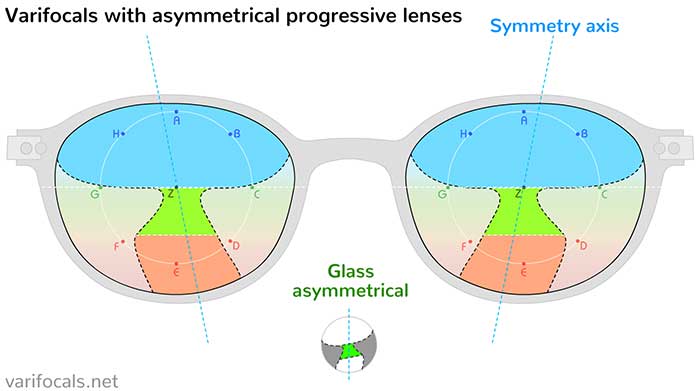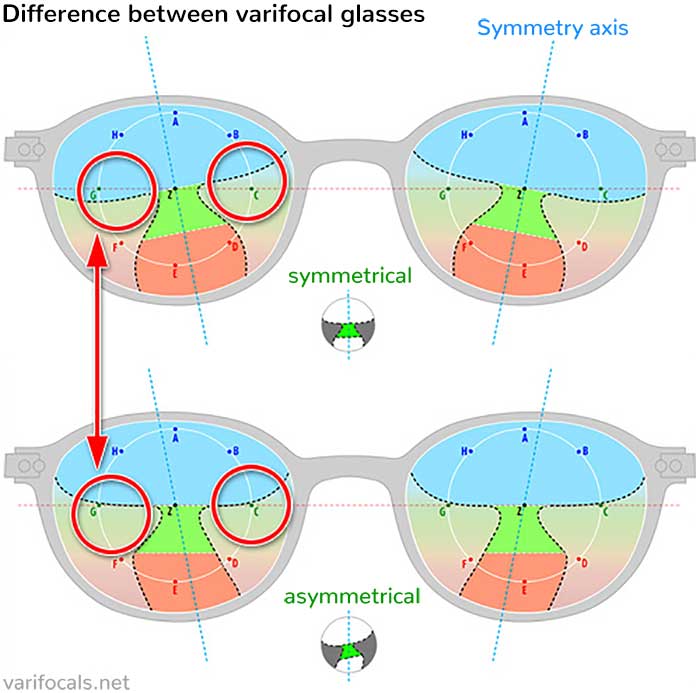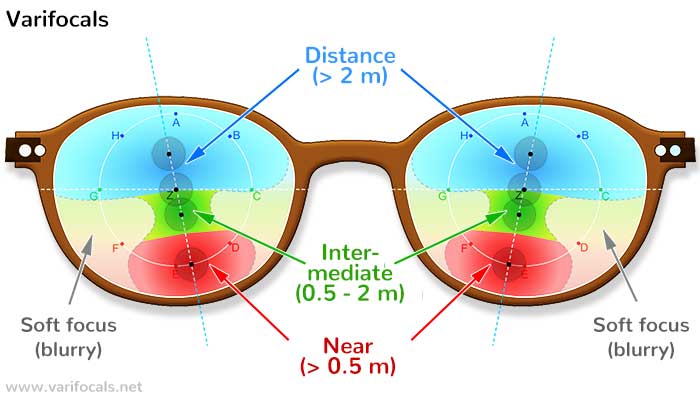Why are asymmetrical varifocal lenses better?
In an asymmetric progressive lens, just like any other asymmetric glasses, the two sides, right and left of the symmetry axis, are different. This means there is a distinction between the right and left lens. As a result, the image quality of the progressive lens is significantly improved, particularly because the well-focused area is substantially enlarged during binocular vision. The symmetry or asymmetry refers to the left and right halves within the lens. The illustration below can illustrate the asynchronicity.

Even though the two lenses of the glasses appear to be symmetrical (they can seemingly be mirrored), upon closer inspection, it becomes evident that the left and right halves within each lens are different. The contrast becomes apparent when compared to the symmetrical progressive lens (as shown in the illustration below).

If you still haven't seen the difference, please pay attention to the reference points "G" and "C" on the horizon line. In the upper lens, the left and right halves of the glass are identical; the glass is just slightly tilted. This is not optimal for vision. In the lower, good asymmetric lens, the left and right sides of the lens are different, asymmetric.
Why are asymmetrical varifocals better?
When looking at the points marked with letters on the graphic above, one can observe that in symmetrical lenses, there is a similarity in the degree of imaging at many points. For example, the "clear vision point G" is still within the well-focused area of the progressive lens on both sides. In the case of asymmetric lenses, both eyes have a uniform visual experience.
Why is the symmetry axis slanted?
The slant of the symmetry axis allows for considering the specific strengths for the left and right eye separately, thereby creating a personalized and optimized visual experience. Through this individual customization, both eyes achieve a consistent visual impression, and the transitions between the different vision areas become smoother.
The asymmetry in the design of the progressive lens enhances the image quality and expands the well-focused vision area for binocular vision. As a result, it enables clearer vision at various distances and increases the wearing comfort of the progressive lens. This personalized approach ensures a better adaptation to the visual needs of each wearer and is a crucial requirement for a high-quality progressive lens.
Characteristics of the Progressive Lens
A progressive lens is a type of multifocal glasses. The special feature lies in the unique lenses, which correct not only refractive visual impairments at one distance but multiple distances simultaneously. The "refractive visual impairments" include commonly occurring vision problems:
- Nearsightedness
- Farsightedness
- Presbyopia
- Astigmatism
A progressive lens becomes relevant when nearsightedness (often congenital) is accompanied by age-related presbyopia. In such cases, distance vision is not clear (due to nearsightedness), and near vision also becomes increasingly challenging (due to presbyopia). The progressive lens can correct both issues thanks to its unique lens design.

Top: Distance vision (over 2 meters);
Middle: Intermediate distances (0.5 to 2 meters), e.g., computer screen;
Bottom: Near vision (less than 0.5 meters), e.g., reading a book;
the lateral zones on the left and right are smoothly curved and often lead to a slightly blurry image
Lens design becomes better and better
The progressive lens manufacturers (e.g. Zeiss, Rodenstock, Essilor) are researching new "lens designs" that differ primarily in terms of the size / extent of the progression zone. As a result, different types of progressive lenses are now available on the market. Please click for more information:
- Simple standard varifocals (symmetrical axis, cheap)
- Varifocals with asymmetrical axis (better lens design)
- Panoramic varifocals for car driving
- Workspace varifocals - middle distance
- Digital varifocals for smartphones, tablets etc.

